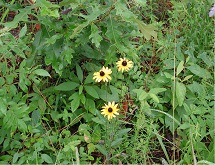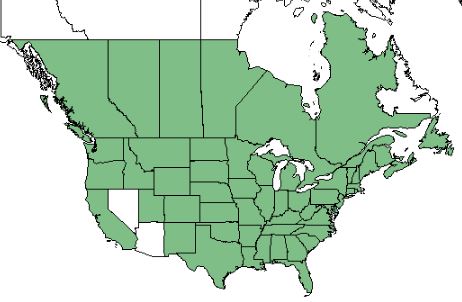Difference between revisions of "Rudbeckia hirta"
(→Ecology) |
(→Ecology) |
||
| Line 40: | Line 40: | ||
''R. hirta'' is not fire resistant, but has medium fire tolerance. <ref name= "USDA Plant Database"/> | ''R. hirta'' is not fire resistant, but has medium fire tolerance. <ref name= "USDA Plant Database"/> | ||
<!--===Pollination===--> | <!--===Pollination===--> | ||
| − | + | ===Use by animals=== | |
| + | Bees have been observed visiting this species. <ref name ="FFE">Observation by Patrick R. Leary, Ralph Simmons State Forest, Nassau Co. Fl., June 14, 2018, posted to Florida Flora and Ecosystematics Facebook Group June 15, 2018. </ref> | ||
| + | <!--Herbivory, granivory, insect hosting, etc.--> | ||
<!--==Diseases and parasites==--> | <!--==Diseases and parasites==--> | ||
Revision as of 17:40, 2 July 2018
Common name: Coastal Plain black-eyed susan [1], black-eyed susan [2]
| Rudbeckia hirta | |
|---|---|

| |
| Photo by Kevin Robertson | |
| Scientific classification | |
| Kingdom: | Plantae |
| Division: | Magnoliophyta - Flowering plants |
| Class: | Magnoliopsida - Dicots |
| Order: | Asterales |
| Family: | Asteraceae |
| Genus: | Rudbeckia |
| Species: | R. hirta |
| Binomial name | |
| Rudbeckia hirta L. | |

| |
| Natural range of Rudbeckia hirta from USDA NRCS Plants Database. | |
Contents
Taxonomic Notes
Synonyms: none
Varieties: R. hirta Linnaeus var. angustifolia (T.V. Moore) Perdue; R. hirta Linnaeus var. hirta; R hirta Linnaeus var. pulcherrima Farwell
Description
R. hirta is an annual/biennial/perennial forb/herb of the Asteraceae family native to North America and Canada and introduced to Alaska. [2]
Distribution
R. hirta is found in all of the United States excluding Nevada and Arizona, all regions of Canada, and Alaska. [2]
Ecology
Habitat
R. hirta proliferates in fields and roadsides. [1] Specimens have been collected from loamy sands at edge od woodland, open woodland, moist roadsides, dry pine woods and fields, moist sandy peat of savannah, longleaf pine wiregrass savanna, saw palmetto flats, old fields, holding ponds, red clay soils, cedar glade, edge of rivers, wet boggy sites, prairie, mixed woods, creek bottoms, slash pine plantation, and other disturbed wet regions. [3]
Phenology
R. hirta flowers all months of the year excluding December-February. [4]
Fire ecology
R. hirta is not fire resistant, but has medium fire tolerance. [2]
Use by animals
Bees have been observed visiting this species. [5]
Conservation and Management
R. hirta is listed as a weedy or invasive species by the Southern Weed Science Society. [2]
Cultivation and restoration
Photo Gallery
References and notes
- ↑ 1.0 1.1 Weakley, A. S. (2015). Flora of the Southern and Mid-Atlantic States. Chapel Hill, NC, University of North Carolina Herbarium.
- ↑ 2.0 2.1 2.2 2.3 2.4 USDA Plant Database https://plants.usda.gov/core/profile?symbol=RUHI2
- ↑ URL: http://herbarium.bio.fsu.edu. Last accessed: June 2018. Collectors: Loran C. Anderson, M.R. Darst, S.F. Blake, Robert Kral, A.H. Curtiss, George R. Cooley, Carroll E. Wood, Kenneth A. Wilson, P.L. Redfearn, J.B. Nelson, R.L. Scott, William Lindsey, Mabel Kral, D.B.WArd, S.S. Ward, Cecil Slaughter, Marc Minno, Brenda Herring, Don Herring, John Small, Robert Lazor, Gary Knight, P. Genelle, G. Fleming, R.J. Eaton, Richard Mitchell, S.W. Leonard, W.T. Penfound, Josephine Skehan, Karl Nestor, Richard Triplett, F. A. Gilbert, Edward Steele, W.F. Westerfeld, R.E. Torrey, E. Bourdo, R.H. Wnek, S.J. Lombardo, K.E. Blum, Norlan Henderson, Delzie Demaree, A.F. Clewell, M. Nee, D.A. Rayner, James Kessler, Roomie Wilson, Sidney McDaniel, Elmo Law, W.F. Westerfeld, Donald Stone, John Thieret, Willis Eggler, Clarke Hudson, E. Bourdo, Charles Bryson, C.R. Ball, Victoria Sullivan, D. Kennemore, George Jones, Robert Thorne, Joscelyn Hill, Cliff Duncun, Richard Clinebell, Lisa Keppner, K. MacClendon, Elmar Prichard, Francis Thorne, J. Kevin England, Jamie England. States and counties: Florida (Leon, Gadsden, Jefferson, Polk, Charlotte, Duval, Wakulla, Gulf, Calhoun, Hardee, Santa Rosa, Marion, Manatee, Citrus, Okaloosa, Jackson, Levy, Seminole, Clay, Hernando, Nassau, Lee, Walton, Suwannee, Sumter, Taylor, holmes, Lake, Washington) Louisiana (St. Tammany, Oachita, Union, Tangipahoa, Evangeline) Mississippi (Jackson, Scott, CLay, George, Kemper), West Virginia (Barbour, Cabell, Preston) Alabama (Wilcox) Virginia (Nottoway, Giles, Patrick, Prince George) Pennsylvania (Huntington) Massachusetts (Hampshire) Missouri (Ripley, Shannon, Douglas, Sullivan, Hickory, McDonald, Henry,Jasper, Carter) Vermont (Windsor) Maryland (Baltimore) South Carolina (Oconee, York, Edgefield, Richland) Tennesssee (Coffee) Arkansas (Garland, Sharp, Clark, Prairie, Faulkner, Pulaski,Marion, Craighead, Hot Spring) Georgia (Thomas, Gwinnett) Colorada (Larimer) Wisconsin (Richalnd) Texas (Harris, Taylor, Freestone) Tennessee (Hickman) North Carolina (Buncombe, Polk, Granville, Caldwell, Burke) Alabama (Geneva, Montgomery, Sumter, Pickens), Kansas (Wooden) Michigan (Baraga) Indiana (Kosciusko) Georgia (Thomas, Camden, Ben Hill, Tift, Morgan) Ohio (Erie)
- ↑ PanFlora Author: Gil Nelson URL: http://www.gilnelson.com/PanFlora/ Date Accessed: 5/29/18
- ↑ Observation by Patrick R. Leary, Ralph Simmons State Forest, Nassau Co. Fl., June 14, 2018, posted to Florida Flora and Ecosystematics Facebook Group June 15, 2018.